Legal and Regulatory Framework Civil Engineering Case Study Analysis
VerifiedAdded on 2020/04/21
|16
|4619
|456
Report
AI Summary
This report, focusing on legal and regulatory frameworks in civil engineering and surveying, analyzes case studies involving contract law and the tort of negligence. The report examines the rights and liabilities of parties in contractual agreements, including breach of contract and available remedies such as damages and specific performance. It also explores negligence, outlining duties of care and potential claims for damages. The analysis includes scenarios involving John, Chris, Peter, Timothy, McKeown, Samson, and William, highlighting the legal options and potential outcomes for each party. The report references key legal precedents like Cutter v. Powell, Addis v. Gramophone, Jarvis v. Swan Tours, and Lumley v. Wagner to support its arguments, providing a comprehensive overview of legal principles and their application in civil engineering contexts.

Paraphrase This Document
Need a fresh take? Get an instant paraphrase of this document with our AI Paraphraser
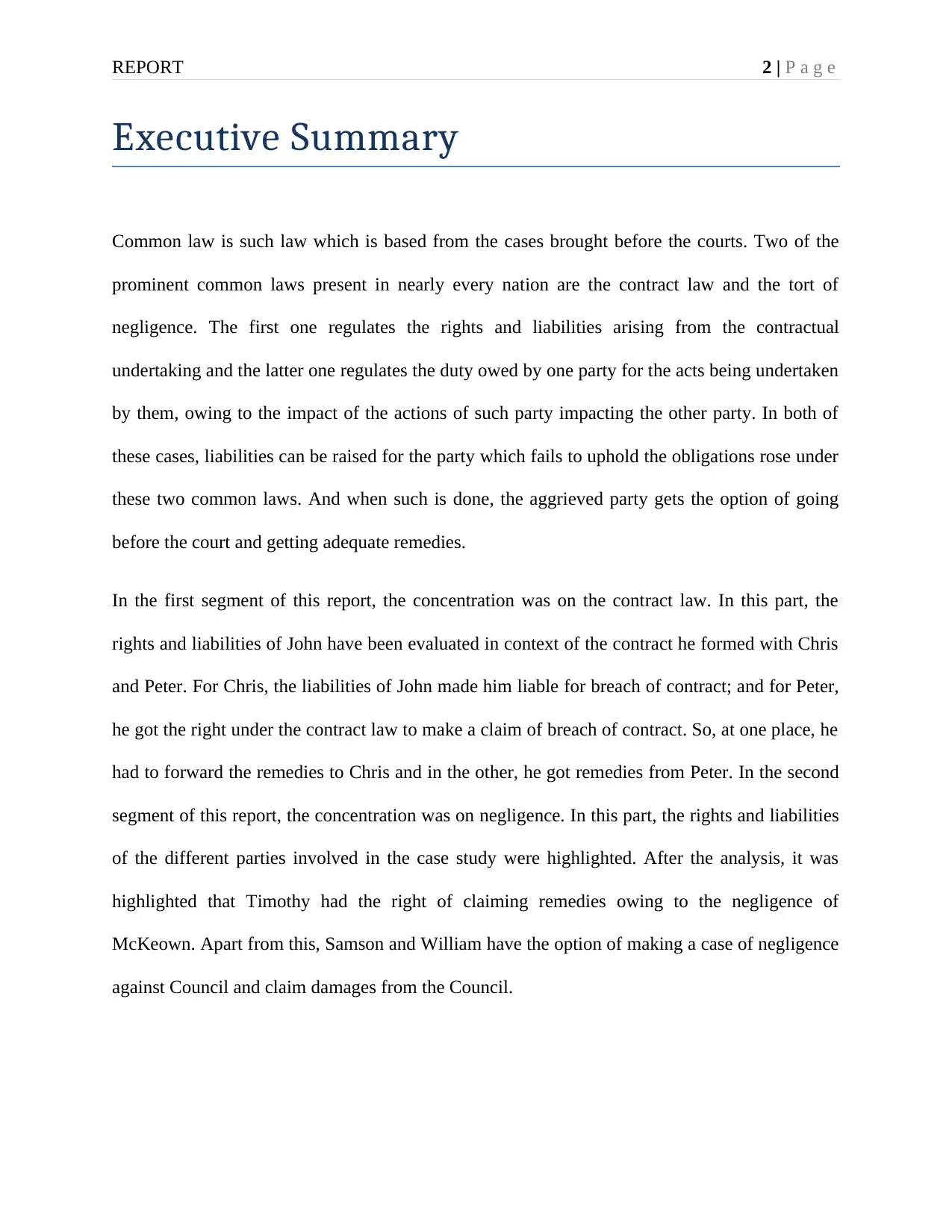
REPORT 2 | P a g e
Executive Summary
Common law is such law which is based from the cases brought before the courts. Two of the
prominent common laws present in nearly every nation are the contract law and the tort of
negligence. The first one regulates the rights and liabilities arising from the contractual
undertaking and the latter one regulates the duty owed by one party for the acts being undertaken
by them, owing to the impact of the actions of such party impacting the other party. In both of
these cases, liabilities can be raised for the party which fails to uphold the obligations rose under
these two common laws. And when such is done, the aggrieved party gets the option of going
before the court and getting adequate remedies.
In the first segment of this report, the concentration was on the contract law. In this part, the
rights and liabilities of John have been evaluated in context of the contract he formed with Chris
and Peter. For Chris, the liabilities of John made him liable for breach of contract; and for Peter,
he got the right under the contract law to make a claim of breach of contract. So, at one place, he
had to forward the remedies to Chris and in the other, he got remedies from Peter. In the second
segment of this report, the concentration was on negligence. In this part, the rights and liabilities
of the different parties involved in the case study were highlighted. After the analysis, it was
highlighted that Timothy had the right of claiming remedies owing to the negligence of
McKeown. Apart from this, Samson and William have the option of making a case of negligence
against Council and claim damages from the Council.
Executive Summary
Common law is such law which is based from the cases brought before the courts. Two of the
prominent common laws present in nearly every nation are the contract law and the tort of
negligence. The first one regulates the rights and liabilities arising from the contractual
undertaking and the latter one regulates the duty owed by one party for the acts being undertaken
by them, owing to the impact of the actions of such party impacting the other party. In both of
these cases, liabilities can be raised for the party which fails to uphold the obligations rose under
these two common laws. And when such is done, the aggrieved party gets the option of going
before the court and getting adequate remedies.
In the first segment of this report, the concentration was on the contract law. In this part, the
rights and liabilities of John have been evaluated in context of the contract he formed with Chris
and Peter. For Chris, the liabilities of John made him liable for breach of contract; and for Peter,
he got the right under the contract law to make a claim of breach of contract. So, at one place, he
had to forward the remedies to Chris and in the other, he got remedies from Peter. In the second
segment of this report, the concentration was on negligence. In this part, the rights and liabilities
of the different parties involved in the case study were highlighted. After the analysis, it was
highlighted that Timothy had the right of claiming remedies owing to the negligence of
McKeown. Apart from this, Samson and William have the option of making a case of negligence
against Council and claim damages from the Council.
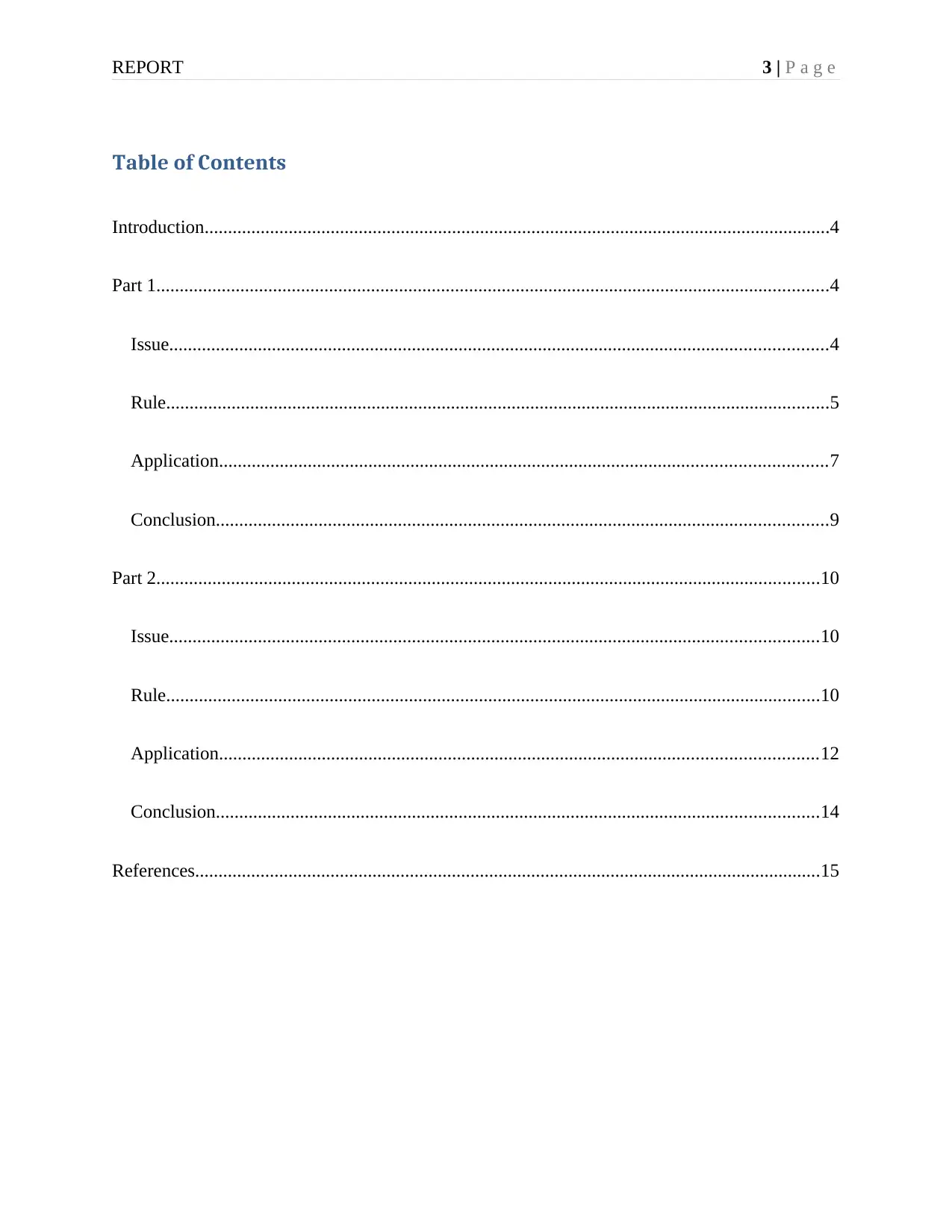
REPORT 3 | P a g e
Table of Contents
Introduction......................................................................................................................................4
Part 1................................................................................................................................................4
Issue.............................................................................................................................................4
Rule..............................................................................................................................................5
Application..................................................................................................................................7
Conclusion...................................................................................................................................9
Part 2..............................................................................................................................................10
Issue...........................................................................................................................................10
Rule............................................................................................................................................10
Application................................................................................................................................12
Conclusion.................................................................................................................................14
References......................................................................................................................................15
Table of Contents
Introduction......................................................................................................................................4
Part 1................................................................................................................................................4
Issue.............................................................................................................................................4
Rule..............................................................................................................................................5
Application..................................................................................................................................7
Conclusion...................................................................................................................................9
Part 2..............................................................................................................................................10
Issue...........................................................................................................................................10
Rule............................................................................................................................................10
Application................................................................................................................................12
Conclusion.................................................................................................................................14
References......................................................................................................................................15
⊘ This is a preview!⊘
Do you want full access?
Subscribe today to unlock all pages.

Trusted by 1+ million students worldwide
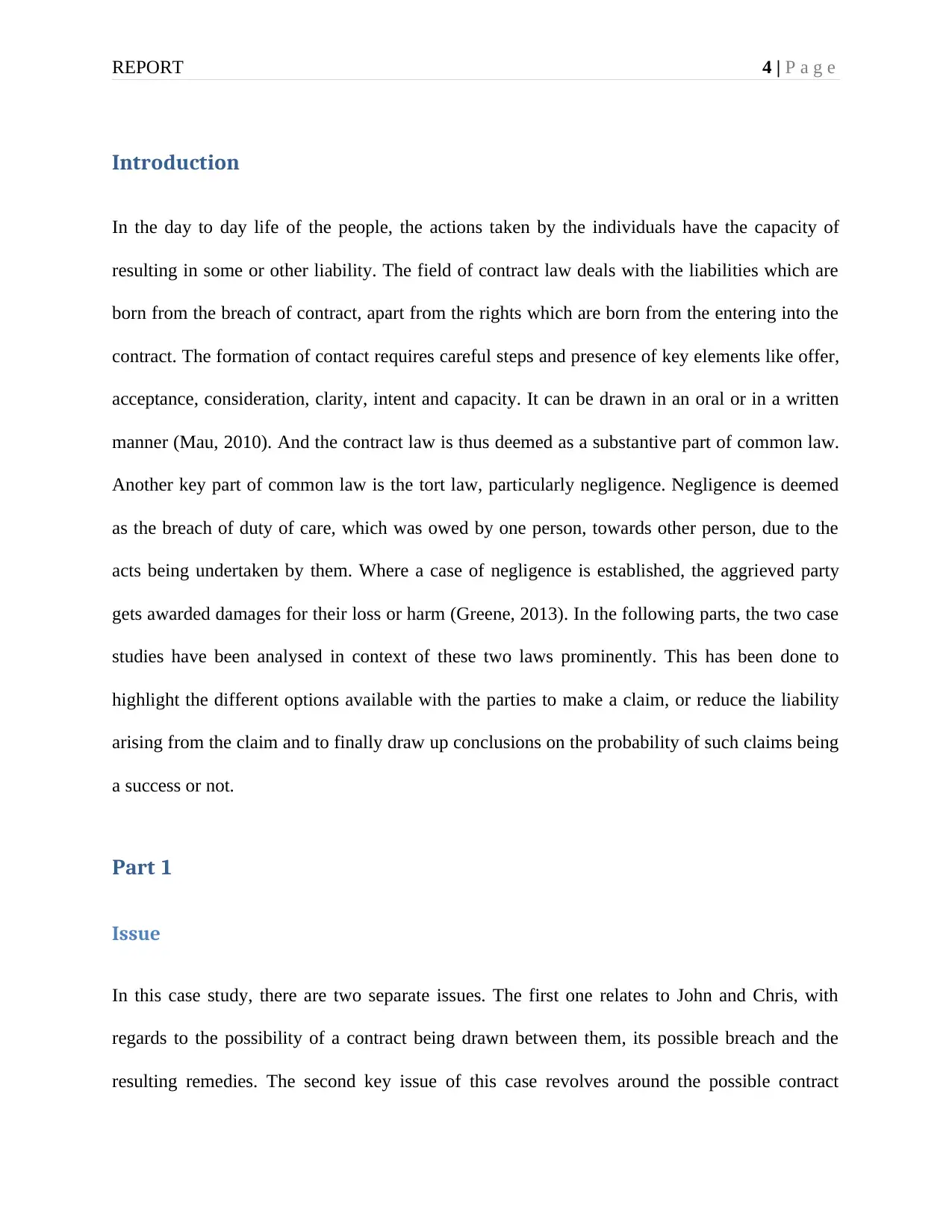
REPORT 4 | P a g e
Introduction
In the day to day life of the people, the actions taken by the individuals have the capacity of
resulting in some or other liability. The field of contract law deals with the liabilities which are
born from the breach of contract, apart from the rights which are born from the entering into the
contract. The formation of contact requires careful steps and presence of key elements like offer,
acceptance, consideration, clarity, intent and capacity. It can be drawn in an oral or in a written
manner (Mau, 2010). And the contract law is thus deemed as a substantive part of common law.
Another key part of common law is the tort law, particularly negligence. Negligence is deemed
as the breach of duty of care, which was owed by one person, towards other person, due to the
acts being undertaken by them. Where a case of negligence is established, the aggrieved party
gets awarded damages for their loss or harm (Greene, 2013). In the following parts, the two case
studies have been analysed in context of these two laws prominently. This has been done to
highlight the different options available with the parties to make a claim, or reduce the liability
arising from the claim and to finally draw up conclusions on the probability of such claims being
a success or not.
Part 1
Issue
In this case study, there are two separate issues. The first one relates to John and Chris, with
regards to the possibility of a contract being drawn between them, its possible breach and the
resulting remedies. The second key issue of this case revolves around the possible contract
Introduction
In the day to day life of the people, the actions taken by the individuals have the capacity of
resulting in some or other liability. The field of contract law deals with the liabilities which are
born from the breach of contract, apart from the rights which are born from the entering into the
contract. The formation of contact requires careful steps and presence of key elements like offer,
acceptance, consideration, clarity, intent and capacity. It can be drawn in an oral or in a written
manner (Mau, 2010). And the contract law is thus deemed as a substantive part of common law.
Another key part of common law is the tort law, particularly negligence. Negligence is deemed
as the breach of duty of care, which was owed by one person, towards other person, due to the
acts being undertaken by them. Where a case of negligence is established, the aggrieved party
gets awarded damages for their loss or harm (Greene, 2013). In the following parts, the two case
studies have been analysed in context of these two laws prominently. This has been done to
highlight the different options available with the parties to make a claim, or reduce the liability
arising from the claim and to finally draw up conclusions on the probability of such claims being
a success or not.
Part 1
Issue
In this case study, there are two separate issues. The first one relates to John and Chris, with
regards to the possibility of a contract being drawn between them, its possible breach and the
resulting remedies. The second key issue of this case revolves around the possible contract
Paraphrase This Document
Need a fresh take? Get an instant paraphrase of this document with our AI Paraphraser
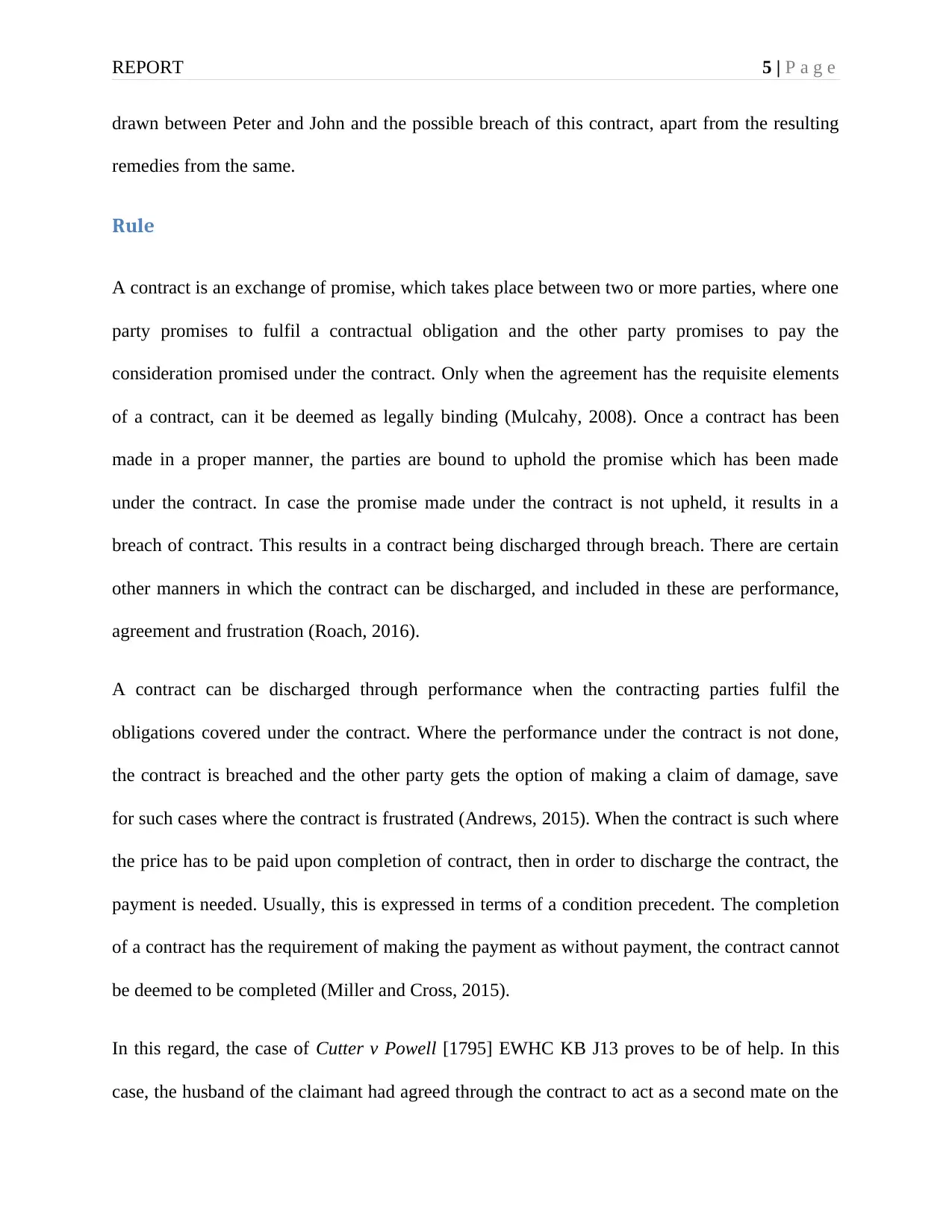
REPORT 5 | P a g e
drawn between Peter and John and the possible breach of this contract, apart from the resulting
remedies from the same.
Rule
A contract is an exchange of promise, which takes place between two or more parties, where one
party promises to fulfil a contractual obligation and the other party promises to pay the
consideration promised under the contract. Only when the agreement has the requisite elements
of a contract, can it be deemed as legally binding (Mulcahy, 2008). Once a contract has been
made in a proper manner, the parties are bound to uphold the promise which has been made
under the contract. In case the promise made under the contract is not upheld, it results in a
breach of contract. This results in a contract being discharged through breach. There are certain
other manners in which the contract can be discharged, and included in these are performance,
agreement and frustration (Roach, 2016).
A contract can be discharged through performance when the contracting parties fulfil the
obligations covered under the contract. Where the performance under the contract is not done,
the contract is breached and the other party gets the option of making a claim of damage, save
for such cases where the contract is frustrated (Andrews, 2015). When the contract is such where
the price has to be paid upon completion of contract, then in order to discharge the contract, the
payment is needed. Usually, this is expressed in terms of a condition precedent. The completion
of a contract has the requirement of making the payment as without payment, the contract cannot
be deemed to be completed (Miller and Cross, 2015).
In this regard, the case of Cutter v Powell [1795] EWHC KB J13 proves to be of help. In this
case, the husband of the claimant had agreed through the contract to act as a second mate on the
drawn between Peter and John and the possible breach of this contract, apart from the resulting
remedies from the same.
Rule
A contract is an exchange of promise, which takes place between two or more parties, where one
party promises to fulfil a contractual obligation and the other party promises to pay the
consideration promised under the contract. Only when the agreement has the requisite elements
of a contract, can it be deemed as legally binding (Mulcahy, 2008). Once a contract has been
made in a proper manner, the parties are bound to uphold the promise which has been made
under the contract. In case the promise made under the contract is not upheld, it results in a
breach of contract. This results in a contract being discharged through breach. There are certain
other manners in which the contract can be discharged, and included in these are performance,
agreement and frustration (Roach, 2016).
A contract can be discharged through performance when the contracting parties fulfil the
obligations covered under the contract. Where the performance under the contract is not done,
the contract is breached and the other party gets the option of making a claim of damage, save
for such cases where the contract is frustrated (Andrews, 2015). When the contract is such where
the price has to be paid upon completion of contract, then in order to discharge the contract, the
payment is needed. Usually, this is expressed in terms of a condition precedent. The completion
of a contract has the requirement of making the payment as without payment, the contract cannot
be deemed to be completed (Miller and Cross, 2015).
In this regard, the case of Cutter v Powell [1795] EWHC KB J13 proves to be of help. In this
case, the husband of the claimant had agreed through the contract to act as a second mate on the
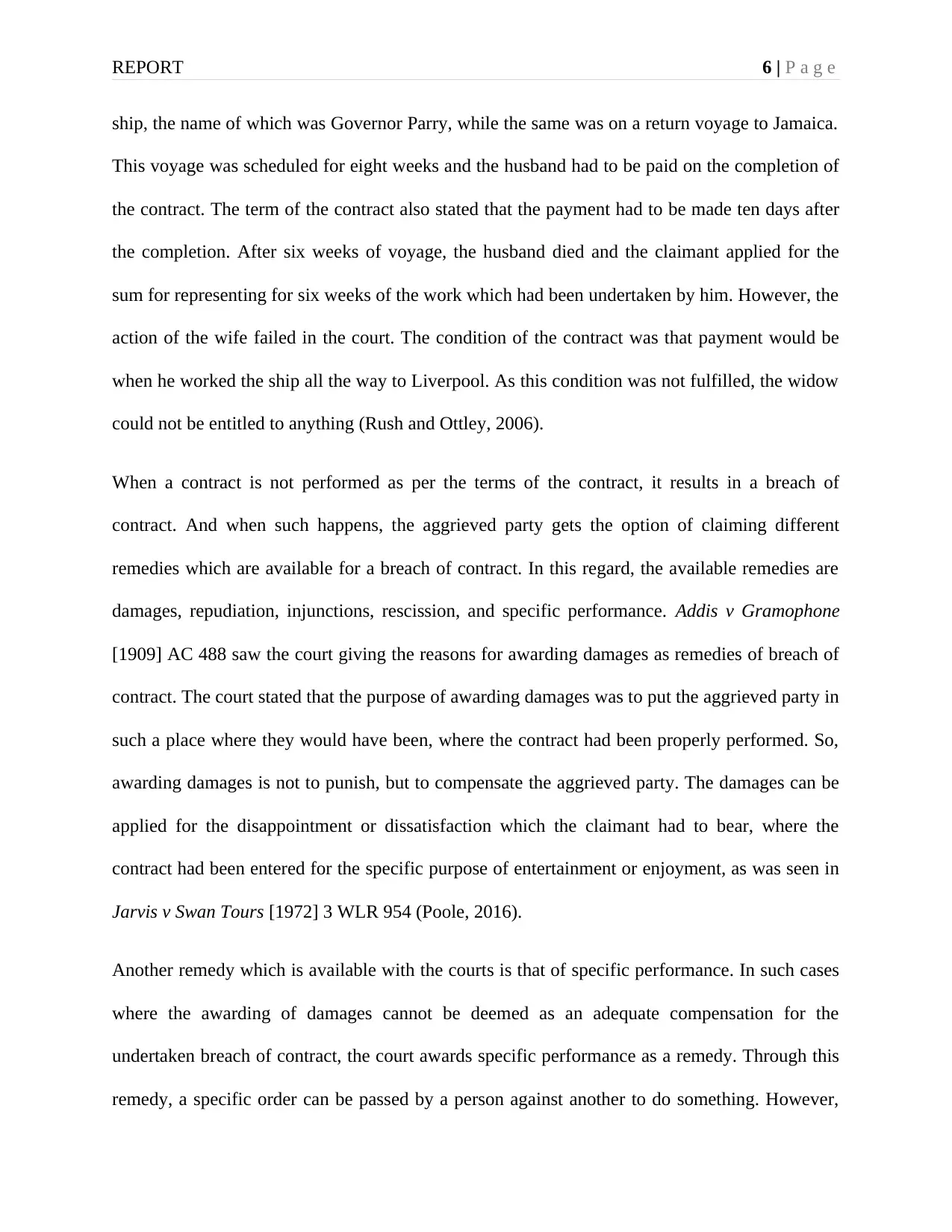
REPORT 6 | P a g e
ship, the name of which was Governor Parry, while the same was on a return voyage to Jamaica.
This voyage was scheduled for eight weeks and the husband had to be paid on the completion of
the contract. The term of the contract also stated that the payment had to be made ten days after
the completion. After six weeks of voyage, the husband died and the claimant applied for the
sum for representing for six weeks of the work which had been undertaken by him. However, the
action of the wife failed in the court. The condition of the contract was that payment would be
when he worked the ship all the way to Liverpool. As this condition was not fulfilled, the widow
could not be entitled to anything (Rush and Ottley, 2006).
When a contract is not performed as per the terms of the contract, it results in a breach of
contract. And when such happens, the aggrieved party gets the option of claiming different
remedies which are available for a breach of contract. In this regard, the available remedies are
damages, repudiation, injunctions, rescission, and specific performance. Addis v Gramophone
[1909] AC 488 saw the court giving the reasons for awarding damages as remedies of breach of
contract. The court stated that the purpose of awarding damages was to put the aggrieved party in
such a place where they would have been, where the contract had been properly performed. So,
awarding damages is not to punish, but to compensate the aggrieved party. The damages can be
applied for the disappointment or dissatisfaction which the claimant had to bear, where the
contract had been entered for the specific purpose of entertainment or enjoyment, as was seen in
Jarvis v Swan Tours [1972] 3 WLR 954 (Poole, 2016).
Another remedy which is available with the courts is that of specific performance. In such cases
where the awarding of damages cannot be deemed as an adequate compensation for the
undertaken breach of contract, the court awards specific performance as a remedy. Through this
remedy, a specific order can be passed by a person against another to do something. However,
ship, the name of which was Governor Parry, while the same was on a return voyage to Jamaica.
This voyage was scheduled for eight weeks and the husband had to be paid on the completion of
the contract. The term of the contract also stated that the payment had to be made ten days after
the completion. After six weeks of voyage, the husband died and the claimant applied for the
sum for representing for six weeks of the work which had been undertaken by him. However, the
action of the wife failed in the court. The condition of the contract was that payment would be
when he worked the ship all the way to Liverpool. As this condition was not fulfilled, the widow
could not be entitled to anything (Rush and Ottley, 2006).
When a contract is not performed as per the terms of the contract, it results in a breach of
contract. And when such happens, the aggrieved party gets the option of claiming different
remedies which are available for a breach of contract. In this regard, the available remedies are
damages, repudiation, injunctions, rescission, and specific performance. Addis v Gramophone
[1909] AC 488 saw the court giving the reasons for awarding damages as remedies of breach of
contract. The court stated that the purpose of awarding damages was to put the aggrieved party in
such a place where they would have been, where the contract had been properly performed. So,
awarding damages is not to punish, but to compensate the aggrieved party. The damages can be
applied for the disappointment or dissatisfaction which the claimant had to bear, where the
contract had been entered for the specific purpose of entertainment or enjoyment, as was seen in
Jarvis v Swan Tours [1972] 3 WLR 954 (Poole, 2016).
Another remedy which is available with the courts is that of specific performance. In such cases
where the awarding of damages cannot be deemed as an adequate compensation for the
undertaken breach of contract, the court awards specific performance as a remedy. Through this
remedy, a specific order can be passed by a person against another to do something. However,
⊘ This is a preview!⊘
Do you want full access?
Subscribe today to unlock all pages.

Trusted by 1+ million students worldwide
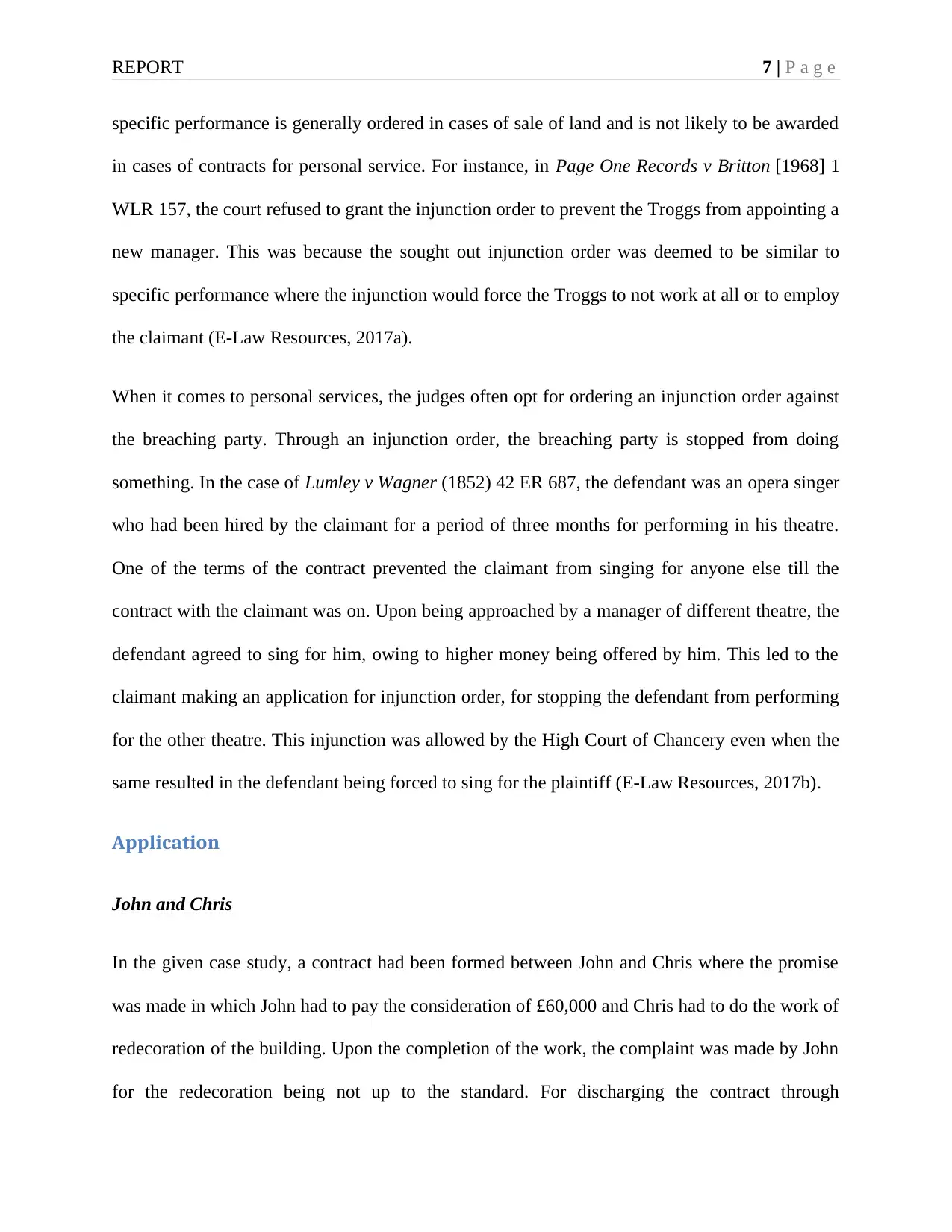
REPORT 7 | P a g e
specific performance is generally ordered in cases of sale of land and is not likely to be awarded
in cases of contracts for personal service. For instance, in Page One Records v Britton [1968] 1
WLR 157, the court refused to grant the injunction order to prevent the Troggs from appointing a
new manager. This was because the sought out injunction order was deemed to be similar to
specific performance where the injunction would force the Troggs to not work at all or to employ
the claimant (E-Law Resources, 2017a).
When it comes to personal services, the judges often opt for ordering an injunction order against
the breaching party. Through an injunction order, the breaching party is stopped from doing
something. In the case of Lumley v Wagner (1852) 42 ER 687, the defendant was an opera singer
who had been hired by the claimant for a period of three months for performing in his theatre.
One of the terms of the contract prevented the claimant from singing for anyone else till the
contract with the claimant was on. Upon being approached by a manager of different theatre, the
defendant agreed to sing for him, owing to higher money being offered by him. This led to the
claimant making an application for injunction order, for stopping the defendant from performing
for the other theatre. This injunction was allowed by the High Court of Chancery even when the
same resulted in the defendant being forced to sing for the plaintiff (E-Law Resources, 2017b).
Application
John and Chris
In the given case study, a contract had been formed between John and Chris where the promise
was made in which John had to pay the consideration of £60,000 and Chris had to do the work of
redecoration of the building. Upon the completion of the work, the complaint was made by John
for the redecoration being not up to the standard. For discharging the contract through
specific performance is generally ordered in cases of sale of land and is not likely to be awarded
in cases of contracts for personal service. For instance, in Page One Records v Britton [1968] 1
WLR 157, the court refused to grant the injunction order to prevent the Troggs from appointing a
new manager. This was because the sought out injunction order was deemed to be similar to
specific performance where the injunction would force the Troggs to not work at all or to employ
the claimant (E-Law Resources, 2017a).
When it comes to personal services, the judges often opt for ordering an injunction order against
the breaching party. Through an injunction order, the breaching party is stopped from doing
something. In the case of Lumley v Wagner (1852) 42 ER 687, the defendant was an opera singer
who had been hired by the claimant for a period of three months for performing in his theatre.
One of the terms of the contract prevented the claimant from singing for anyone else till the
contract with the claimant was on. Upon being approached by a manager of different theatre, the
defendant agreed to sing for him, owing to higher money being offered by him. This led to the
claimant making an application for injunction order, for stopping the defendant from performing
for the other theatre. This injunction was allowed by the High Court of Chancery even when the
same resulted in the defendant being forced to sing for the plaintiff (E-Law Resources, 2017b).
Application
John and Chris
In the given case study, a contract had been formed between John and Chris where the promise
was made in which John had to pay the consideration of £60,000 and Chris had to do the work of
redecoration of the building. Upon the completion of the work, the complaint was made by John
for the redecoration being not up to the standard. For discharging the contract through
Paraphrase This Document
Need a fresh take? Get an instant paraphrase of this document with our AI Paraphraser
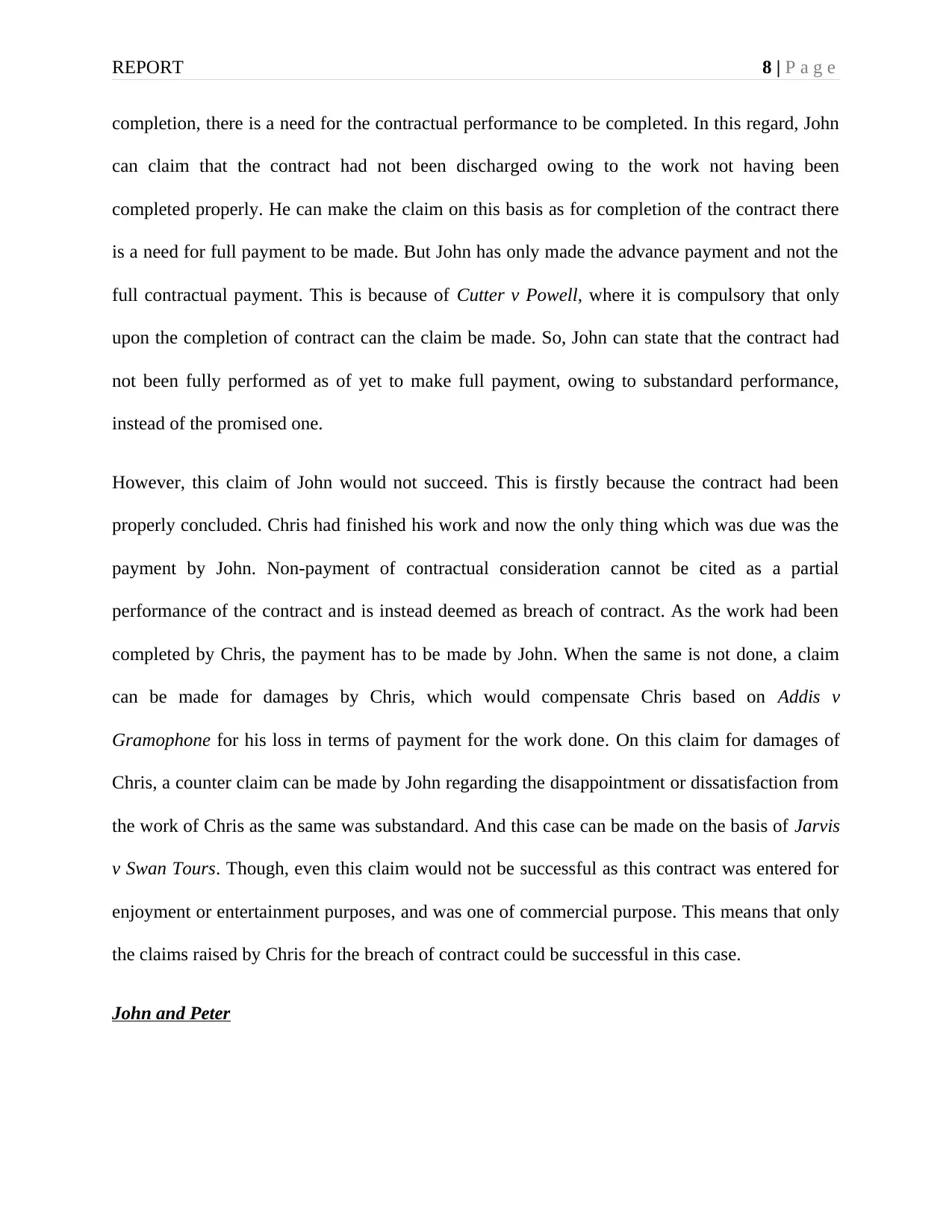
REPORT 8 | P a g e
completion, there is a need for the contractual performance to be completed. In this regard, John
can claim that the contract had not been discharged owing to the work not having been
completed properly. He can make the claim on this basis as for completion of the contract there
is a need for full payment to be made. But John has only made the advance payment and not the
full contractual payment. This is because of Cutter v Powell, where it is compulsory that only
upon the completion of contract can the claim be made. So, John can state that the contract had
not been fully performed as of yet to make full payment, owing to substandard performance,
instead of the promised one.
However, this claim of John would not succeed. This is firstly because the contract had been
properly concluded. Chris had finished his work and now the only thing which was due was the
payment by John. Non-payment of contractual consideration cannot be cited as a partial
performance of the contract and is instead deemed as breach of contract. As the work had been
completed by Chris, the payment has to be made by John. When the same is not done, a claim
can be made for damages by Chris, which would compensate Chris based on Addis v
Gramophone for his loss in terms of payment for the work done. On this claim for damages of
Chris, a counter claim can be made by John regarding the disappointment or dissatisfaction from
the work of Chris as the same was substandard. And this case can be made on the basis of Jarvis
v Swan Tours. Though, even this claim would not be successful as this contract was entered for
enjoyment or entertainment purposes, and was one of commercial purpose. This means that only
the claims raised by Chris for the breach of contract could be successful in this case.
John and Peter
completion, there is a need for the contractual performance to be completed. In this regard, John
can claim that the contract had not been discharged owing to the work not having been
completed properly. He can make the claim on this basis as for completion of the contract there
is a need for full payment to be made. But John has only made the advance payment and not the
full contractual payment. This is because of Cutter v Powell, where it is compulsory that only
upon the completion of contract can the claim be made. So, John can state that the contract had
not been fully performed as of yet to make full payment, owing to substandard performance,
instead of the promised one.
However, this claim of John would not succeed. This is firstly because the contract had been
properly concluded. Chris had finished his work and now the only thing which was due was the
payment by John. Non-payment of contractual consideration cannot be cited as a partial
performance of the contract and is instead deemed as breach of contract. As the work had been
completed by Chris, the payment has to be made by John. When the same is not done, a claim
can be made for damages by Chris, which would compensate Chris based on Addis v
Gramophone for his loss in terms of payment for the work done. On this claim for damages of
Chris, a counter claim can be made by John regarding the disappointment or dissatisfaction from
the work of Chris as the same was substandard. And this case can be made on the basis of Jarvis
v Swan Tours. Though, even this claim would not be successful as this contract was entered for
enjoyment or entertainment purposes, and was one of commercial purpose. This means that only
the claims raised by Chris for the breach of contract could be successful in this case.
John and Peter
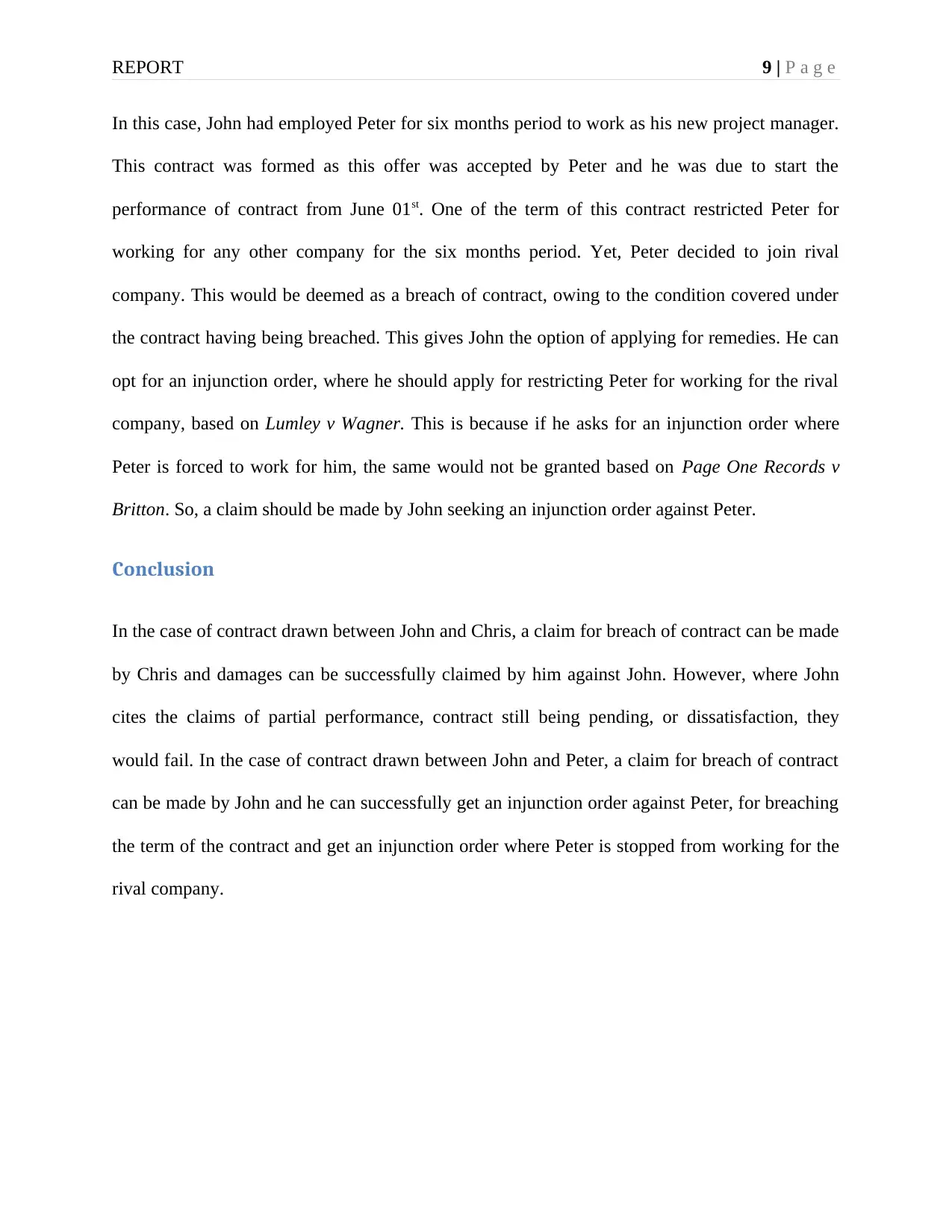
REPORT 9 | P a g e
In this case, John had employed Peter for six months period to work as his new project manager.
This contract was formed as this offer was accepted by Peter and he was due to start the
performance of contract from June 01st. One of the term of this contract restricted Peter for
working for any other company for the six months period. Yet, Peter decided to join rival
company. This would be deemed as a breach of contract, owing to the condition covered under
the contract having being breached. This gives John the option of applying for remedies. He can
opt for an injunction order, where he should apply for restricting Peter for working for the rival
company, based on Lumley v Wagner. This is because if he asks for an injunction order where
Peter is forced to work for him, the same would not be granted based on Page One Records v
Britton. So, a claim should be made by John seeking an injunction order against Peter.
Conclusion
In the case of contract drawn between John and Chris, a claim for breach of contract can be made
by Chris and damages can be successfully claimed by him against John. However, where John
cites the claims of partial performance, contract still being pending, or dissatisfaction, they
would fail. In the case of contract drawn between John and Peter, a claim for breach of contract
can be made by John and he can successfully get an injunction order against Peter, for breaching
the term of the contract and get an injunction order where Peter is stopped from working for the
rival company.
In this case, John had employed Peter for six months period to work as his new project manager.
This contract was formed as this offer was accepted by Peter and he was due to start the
performance of contract from June 01st. One of the term of this contract restricted Peter for
working for any other company for the six months period. Yet, Peter decided to join rival
company. This would be deemed as a breach of contract, owing to the condition covered under
the contract having being breached. This gives John the option of applying for remedies. He can
opt for an injunction order, where he should apply for restricting Peter for working for the rival
company, based on Lumley v Wagner. This is because if he asks for an injunction order where
Peter is forced to work for him, the same would not be granted based on Page One Records v
Britton. So, a claim should be made by John seeking an injunction order against Peter.
Conclusion
In the case of contract drawn between John and Chris, a claim for breach of contract can be made
by Chris and damages can be successfully claimed by him against John. However, where John
cites the claims of partial performance, contract still being pending, or dissatisfaction, they
would fail. In the case of contract drawn between John and Peter, a claim for breach of contract
can be made by John and he can successfully get an injunction order against Peter, for breaching
the term of the contract and get an injunction order where Peter is stopped from working for the
rival company.
⊘ This is a preview!⊘
Do you want full access?
Subscribe today to unlock all pages.

Trusted by 1+ million students worldwide
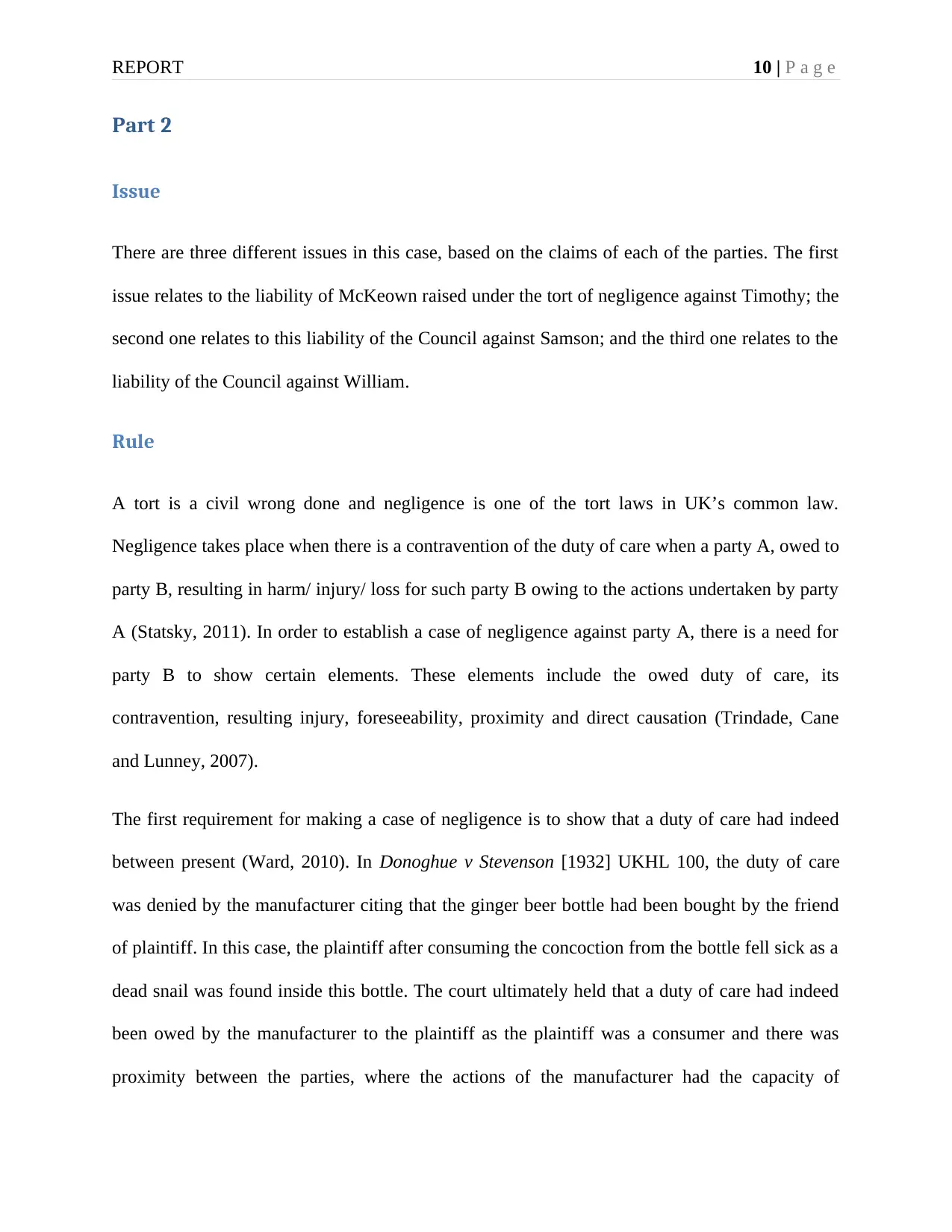
REPORT 10 | P a g e
Part 2
Issue
There are three different issues in this case, based on the claims of each of the parties. The first
issue relates to the liability of McKeown raised under the tort of negligence against Timothy; the
second one relates to this liability of the Council against Samson; and the third one relates to the
liability of the Council against William.
Rule
A tort is a civil wrong done and negligence is one of the tort laws in UK’s common law.
Negligence takes place when there is a contravention of the duty of care when a party A, owed to
party B, resulting in harm/ injury/ loss for such party B owing to the actions undertaken by party
A (Statsky, 2011). In order to establish a case of negligence against party A, there is a need for
party B to show certain elements. These elements include the owed duty of care, its
contravention, resulting injury, foreseeability, proximity and direct causation (Trindade, Cane
and Lunney, 2007).
The first requirement for making a case of negligence is to show that a duty of care had indeed
between present (Ward, 2010). In Donoghue v Stevenson [1932] UKHL 100, the duty of care
was denied by the manufacturer citing that the ginger beer bottle had been bought by the friend
of plaintiff. In this case, the plaintiff after consuming the concoction from the bottle fell sick as a
dead snail was found inside this bottle. The court ultimately held that a duty of care had indeed
been owed by the manufacturer to the plaintiff as the plaintiff was a consumer and there was
proximity between the parties, where the actions of the manufacturer had the capacity of
Part 2
Issue
There are three different issues in this case, based on the claims of each of the parties. The first
issue relates to the liability of McKeown raised under the tort of negligence against Timothy; the
second one relates to this liability of the Council against Samson; and the third one relates to the
liability of the Council against William.
Rule
A tort is a civil wrong done and negligence is one of the tort laws in UK’s common law.
Negligence takes place when there is a contravention of the duty of care when a party A, owed to
party B, resulting in harm/ injury/ loss for such party B owing to the actions undertaken by party
A (Statsky, 2011). In order to establish a case of negligence against party A, there is a need for
party B to show certain elements. These elements include the owed duty of care, its
contravention, resulting injury, foreseeability, proximity and direct causation (Trindade, Cane
and Lunney, 2007).
The first requirement for making a case of negligence is to show that a duty of care had indeed
between present (Ward, 2010). In Donoghue v Stevenson [1932] UKHL 100, the duty of care
was denied by the manufacturer citing that the ginger beer bottle had been bought by the friend
of plaintiff. In this case, the plaintiff after consuming the concoction from the bottle fell sick as a
dead snail was found inside this bottle. The court ultimately held that a duty of care had indeed
been owed by the manufacturer to the plaintiff as the plaintiff was a consumer and there was
proximity between the parties, where the actions of the manufacturer had the capacity of
Paraphrase This Document
Need a fresh take? Get an instant paraphrase of this document with our AI Paraphraser
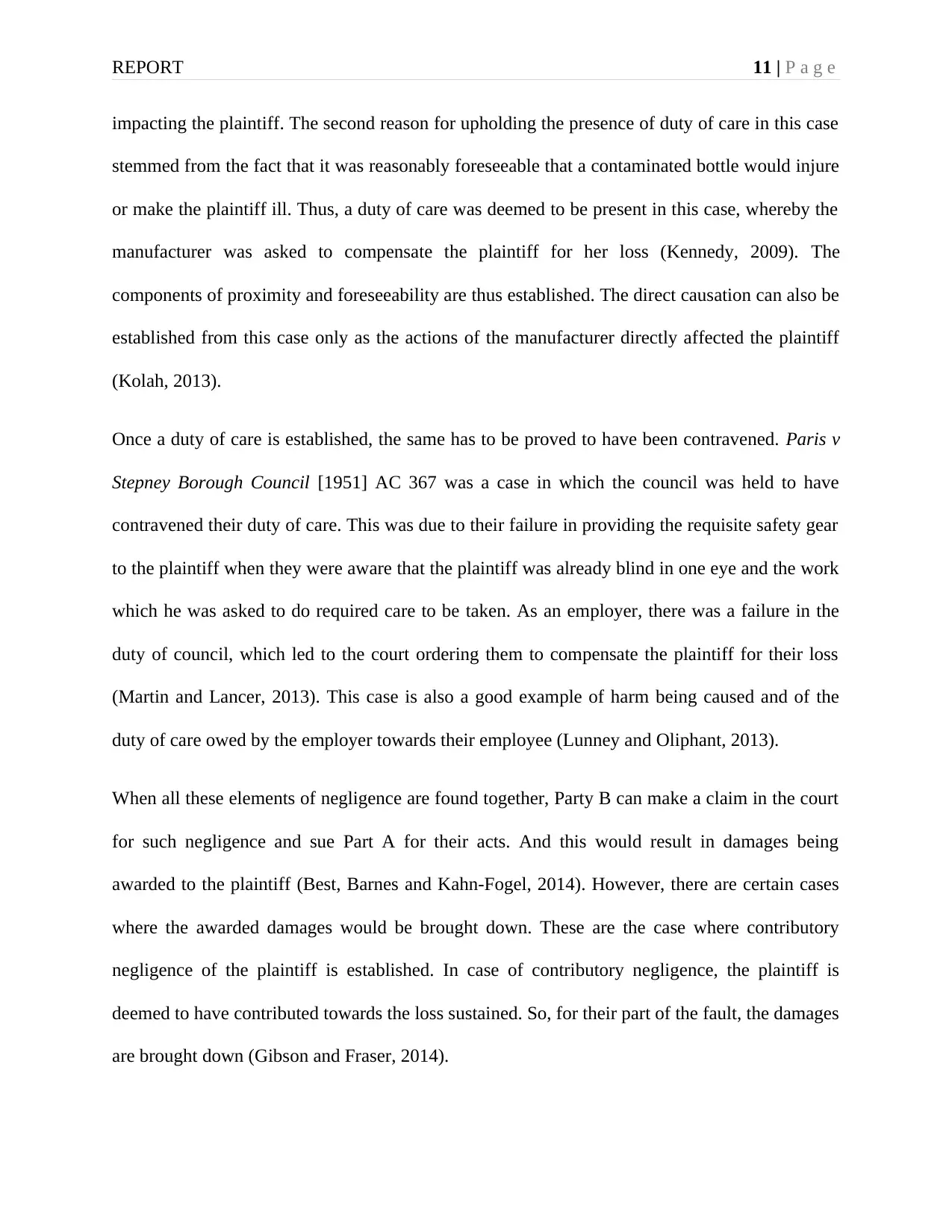
REPORT 11 | P a g e
impacting the plaintiff. The second reason for upholding the presence of duty of care in this case
stemmed from the fact that it was reasonably foreseeable that a contaminated bottle would injure
or make the plaintiff ill. Thus, a duty of care was deemed to be present in this case, whereby the
manufacturer was asked to compensate the plaintiff for her loss (Kennedy, 2009). The
components of proximity and foreseeability are thus established. The direct causation can also be
established from this case only as the actions of the manufacturer directly affected the plaintiff
(Kolah, 2013).
Once a duty of care is established, the same has to be proved to have been contravened. Paris v
Stepney Borough Council [1951] AC 367 was a case in which the council was held to have
contravened their duty of care. This was due to their failure in providing the requisite safety gear
to the plaintiff when they were aware that the plaintiff was already blind in one eye and the work
which he was asked to do required care to be taken. As an employer, there was a failure in the
duty of council, which led to the court ordering them to compensate the plaintiff for their loss
(Martin and Lancer, 2013). This case is also a good example of harm being caused and of the
duty of care owed by the employer towards their employee (Lunney and Oliphant, 2013).
When all these elements of negligence are found together, Party B can make a claim in the court
for such negligence and sue Part A for their acts. And this would result in damages being
awarded to the plaintiff (Best, Barnes and Kahn-Fogel, 2014). However, there are certain cases
where the awarded damages would be brought down. These are the case where contributory
negligence of the plaintiff is established. In case of contributory negligence, the plaintiff is
deemed to have contributed towards the loss sustained. So, for their part of the fault, the damages
are brought down (Gibson and Fraser, 2014).
impacting the plaintiff. The second reason for upholding the presence of duty of care in this case
stemmed from the fact that it was reasonably foreseeable that a contaminated bottle would injure
or make the plaintiff ill. Thus, a duty of care was deemed to be present in this case, whereby the
manufacturer was asked to compensate the plaintiff for her loss (Kennedy, 2009). The
components of proximity and foreseeability are thus established. The direct causation can also be
established from this case only as the actions of the manufacturer directly affected the plaintiff
(Kolah, 2013).
Once a duty of care is established, the same has to be proved to have been contravened. Paris v
Stepney Borough Council [1951] AC 367 was a case in which the council was held to have
contravened their duty of care. This was due to their failure in providing the requisite safety gear
to the plaintiff when they were aware that the plaintiff was already blind in one eye and the work
which he was asked to do required care to be taken. As an employer, there was a failure in the
duty of council, which led to the court ordering them to compensate the plaintiff for their loss
(Martin and Lancer, 2013). This case is also a good example of harm being caused and of the
duty of care owed by the employer towards their employee (Lunney and Oliphant, 2013).
When all these elements of negligence are found together, Party B can make a claim in the court
for such negligence and sue Part A for their acts. And this would result in damages being
awarded to the plaintiff (Best, Barnes and Kahn-Fogel, 2014). However, there are certain cases
where the awarded damages would be brought down. These are the case where contributory
negligence of the plaintiff is established. In case of contributory negligence, the plaintiff is
deemed to have contributed towards the loss sustained. So, for their part of the fault, the damages
are brought down (Gibson and Fraser, 2014).
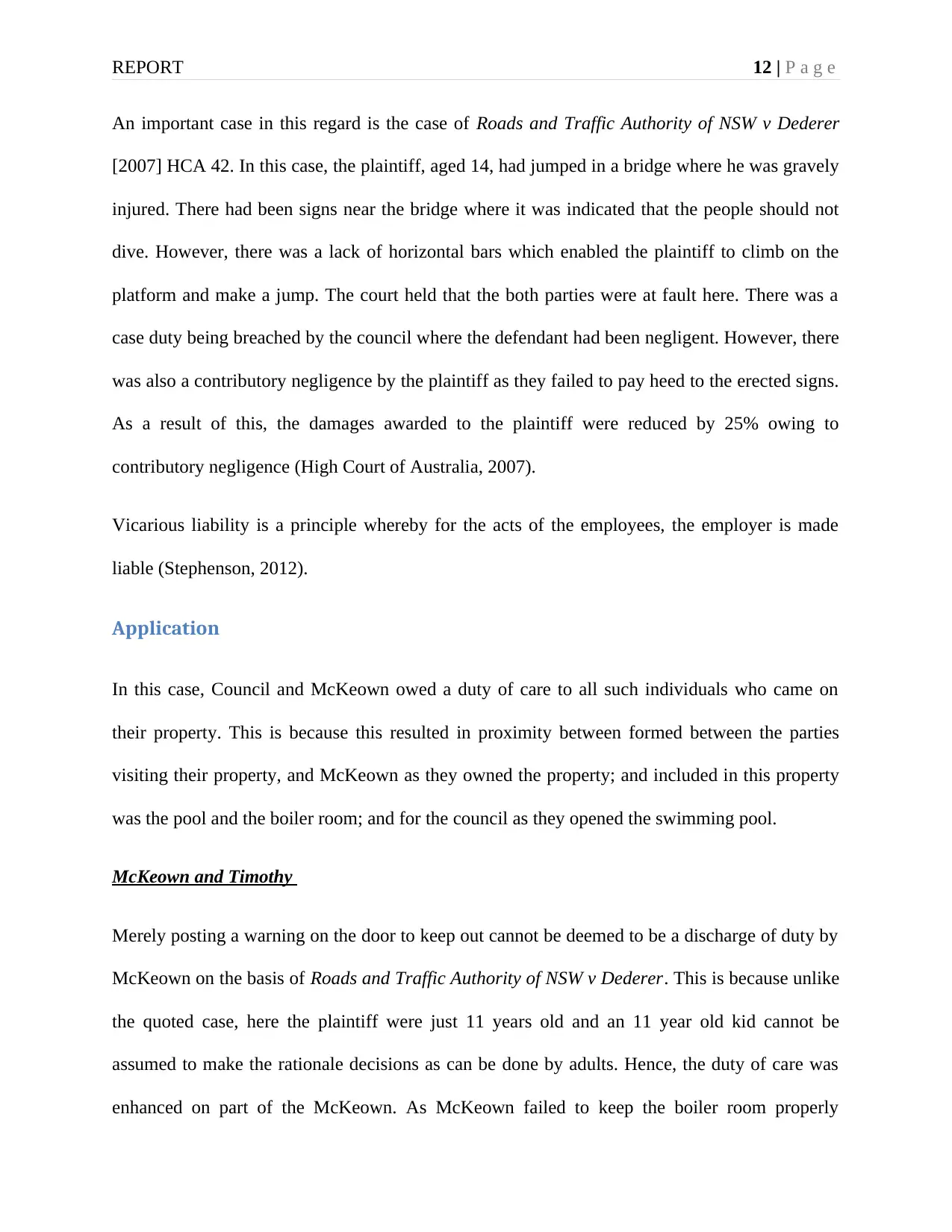
REPORT 12 | P a g e
An important case in this regard is the case of Roads and Traffic Authority of NSW v Dederer
[2007] HCA 42. In this case, the plaintiff, aged 14, had jumped in a bridge where he was gravely
injured. There had been signs near the bridge where it was indicated that the people should not
dive. However, there was a lack of horizontal bars which enabled the plaintiff to climb on the
platform and make a jump. The court held that the both parties were at fault here. There was a
case duty being breached by the council where the defendant had been negligent. However, there
was also a contributory negligence by the plaintiff as they failed to pay heed to the erected signs.
As a result of this, the damages awarded to the plaintiff were reduced by 25% owing to
contributory negligence (High Court of Australia, 2007).
Vicarious liability is a principle whereby for the acts of the employees, the employer is made
liable (Stephenson, 2012).
Application
In this case, Council and McKeown owed a duty of care to all such individuals who came on
their property. This is because this resulted in proximity between formed between the parties
visiting their property, and McKeown as they owned the property; and included in this property
was the pool and the boiler room; and for the council as they opened the swimming pool.
McKeown and Timothy
Merely posting a warning on the door to keep out cannot be deemed to be a discharge of duty by
McKeown on the basis of Roads and Traffic Authority of NSW v Dederer. This is because unlike
the quoted case, here the plaintiff were just 11 years old and an 11 year old kid cannot be
assumed to make the rationale decisions as can be done by adults. Hence, the duty of care was
enhanced on part of the McKeown. As McKeown failed to keep the boiler room properly
An important case in this regard is the case of Roads and Traffic Authority of NSW v Dederer
[2007] HCA 42. In this case, the plaintiff, aged 14, had jumped in a bridge where he was gravely
injured. There had been signs near the bridge where it was indicated that the people should not
dive. However, there was a lack of horizontal bars which enabled the plaintiff to climb on the
platform and make a jump. The court held that the both parties were at fault here. There was a
case duty being breached by the council where the defendant had been negligent. However, there
was also a contributory negligence by the plaintiff as they failed to pay heed to the erected signs.
As a result of this, the damages awarded to the plaintiff were reduced by 25% owing to
contributory negligence (High Court of Australia, 2007).
Vicarious liability is a principle whereby for the acts of the employees, the employer is made
liable (Stephenson, 2012).
Application
In this case, Council and McKeown owed a duty of care to all such individuals who came on
their property. This is because this resulted in proximity between formed between the parties
visiting their property, and McKeown as they owned the property; and included in this property
was the pool and the boiler room; and for the council as they opened the swimming pool.
McKeown and Timothy
Merely posting a warning on the door to keep out cannot be deemed to be a discharge of duty by
McKeown on the basis of Roads and Traffic Authority of NSW v Dederer. This is because unlike
the quoted case, here the plaintiff were just 11 years old and an 11 year old kid cannot be
assumed to make the rationale decisions as can be done by adults. Hence, the duty of care was
enhanced on part of the McKeown. As McKeown failed to keep the boiler room properly
⊘ This is a preview!⊘
Do you want full access?
Subscribe today to unlock all pages.

Trusted by 1+ million students worldwide
1 out of 16
Related Documents
Your All-in-One AI-Powered Toolkit for Academic Success.
+13062052269
info@desklib.com
Available 24*7 on WhatsApp / Email
![[object Object]](/_next/static/media/star-bottom.7253800d.svg)
Unlock your academic potential
Copyright © 2020–2025 A2Z Services. All Rights Reserved. Developed and managed by ZUCOL.




